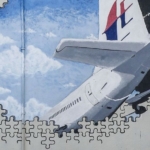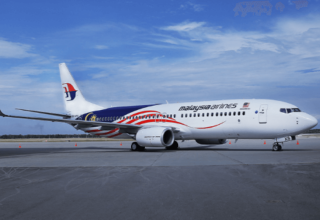Last updated on March 5th, 2024 at 11:51 am
It has been 10 years since Malaysia Airlines Flight 370 (MH370) vanished from the radar screens, leaving behind a trail of mystery and grief. The Boeing 777 aircraft, carrying 239 people on board, was en route from Kuala Lumpur to Beijing on March 8, 2014, when it deviated from its planned route and flew for hours over the Indian Ocean before presumably crashing into the sea. Despite extensive search efforts, the main wreckage and the black boxes have never been found, making it one of the greatest aviation mysteries of all time.
In the aftermath of the tragedy, Malaysia proposed a new safety measure to prevent such a scenario from happening again: real-time tracking of commercial planes. The idea was to ensure that authorities would always know the location and status of any aircraft in distress, and be able to locate the crash site within a narrow radius. However, a decade later, the implementation of this measure has been delayed and diluted, leaving the aviation industry vulnerable to another potential disaster.
The Proposal and the Resistance
Malaysia was the first country to propose real-time tracking of planes to the International Civil Aviation Organization (ICAO), the United Nations agency that sets standards and regulations for global aviation. In a preliminary report submitted to ICAO in April 2014, the Malaysian Air Accident Investigation Bureau recommended that ICAO consider making it mandatory for commercial aircraft to be equipped with a system that can autonomously transmit information on their position, speed, altitude, and heading at least once every minute, especially when they are in distress or flying over remote areas.
The proposal was based on the fact that MH370’s transponder, which normally sends regular signals to air traffic control, was manually switched off by someone on board, making it impossible to track the plane’s movements. The only clues to the plane’s whereabouts came from sporadic satellite pings, which were not designed to provide precise location data. The last ping was received at 8:19 a.m. local time, more than seven hours after the plane took off, indicating that the plane had run out of fuel and crashed somewhere in the southern Indian Ocean.
However, the proposal faced resistance from some airlines and aircraft manufacturers, who argued that it would be too costly and complex to implement, and that it would raise privacy and security concerns. They also claimed that the existing systems, such as the Aircraft Communications Addressing and Reporting System (ACARS) and the Automatic Dependent Surveillance-Broadcast (ADS-B), were sufficient to track planes in most cases, and that the MH370 incident was an extremely rare and exceptional event.
The Compromise and the Delay
In response to the opposition, ICAO revised its proposal and came up with a compromise solution: the Global Aeronautical Distress and Safety System (GADSS). The GADSS consists of two main components: normal aircraft tracking and autonomous distress tracking. The normal aircraft tracking requires planes to report their position at least every 15 minutes, while the autonomous distress tracking requires planes to report their position at least every minute when they are in an abnormal situation, such as a sudden change in altitude, speed, or direction.
Keep Reading
The GADSS also requires planes to have a tamper-proof device that can record flight data and voice communications, and transmit or eject them in the event of a crash. This device, known as the flight recorder, is intended to supplement the traditional black boxes, which are often difficult to recover from deep waters or remote terrains.
The GADSS was initially scheduled to take effect in January 2021, but it was postponed to January 2025 due to the Covid-19 pandemic, which severely disrupted the aviation industry and reduced the demand for air travel. The pandemic also affected the production and delivery of new aircraft, which are supposed to be equipped with the GADSS-compliant systems.
The Reality and the Risk
Despite the GADSS being a watered-down version of Malaysia’s original proposal, it still faces challenges and uncertainties in its implementation and enforcement. According to a survey conducted by the International Air Transport Association (IATA) in 2019, only 30% of the airlines had implemented the normal aircraft tracking, and only 10% had implemented the autonomous distress tracking. The survey also found that the main barriers to the adoption of the GADSS were the lack of regulatory guidance, the high cost of equipment and installation, and the technical and operational issues.
Moreover, the GADSS is not a binding regulation, but a recommendation that relies on the voluntary compliance of the airlines and the oversight of the national authorities. This means that there is no guarantee that all planes will follow the GADSS standards, and that there is no mechanism to monitor and enforce the compliance. Furthermore, the GADSS does not address the possibility of human interference or sabotage, which could disable or manipulate the tracking systems, as was suspected in the case of MH370.
Therefore, the risk of losing another plane like MH370 remains real and present, especially as the air travel recovers from the pandemic and more planes resume flying over vast and remote areas, such as the oceans, the poles, and the deserts. The experts and the families of the MH370 victims have urged the aviation industry and the regulators to expedite and strengthen the implementation of the GADSS, and to ensure that every plane is traceable and accountable at all times.
Malaysia’s call for real-time tracking of planes has been largely unheeded 10 years after MH370, despite the efforts and the compromises made by the ICAO and the aviation stakeholders. The GADSS, which is supposed to enhance the safety and the security of global aviation, has been delayed and diluted, leaving the industry exposed to another potential catastrophe. The MH370 incident has shown that the existing systems are not adequate to prevent and respond to such a scenario, and that the need for a robust and reliable tracking system is urgent and imperative. The aviation industry and the regulators should not wait for another tragedy to happen before they take action, but should act now to ensure that no plane and no passenger is ever lost again.

























